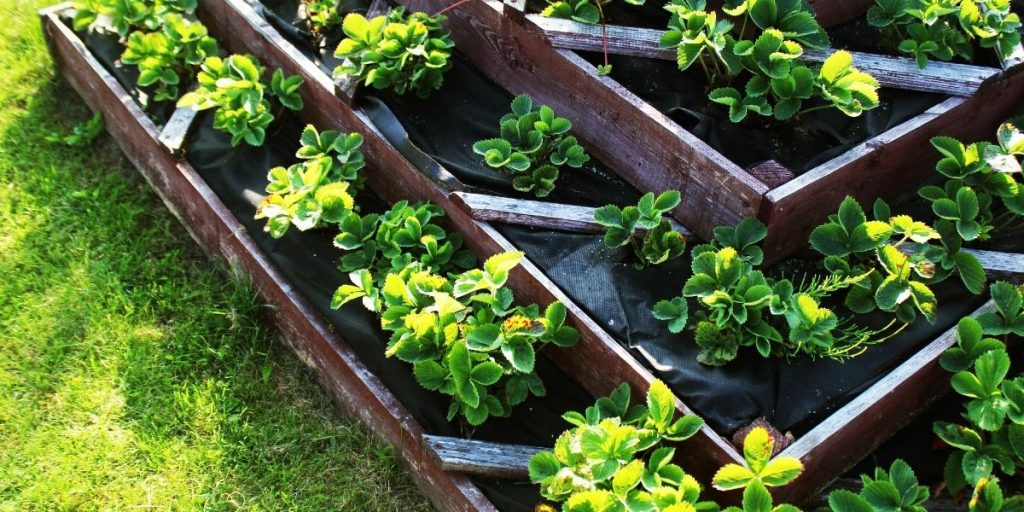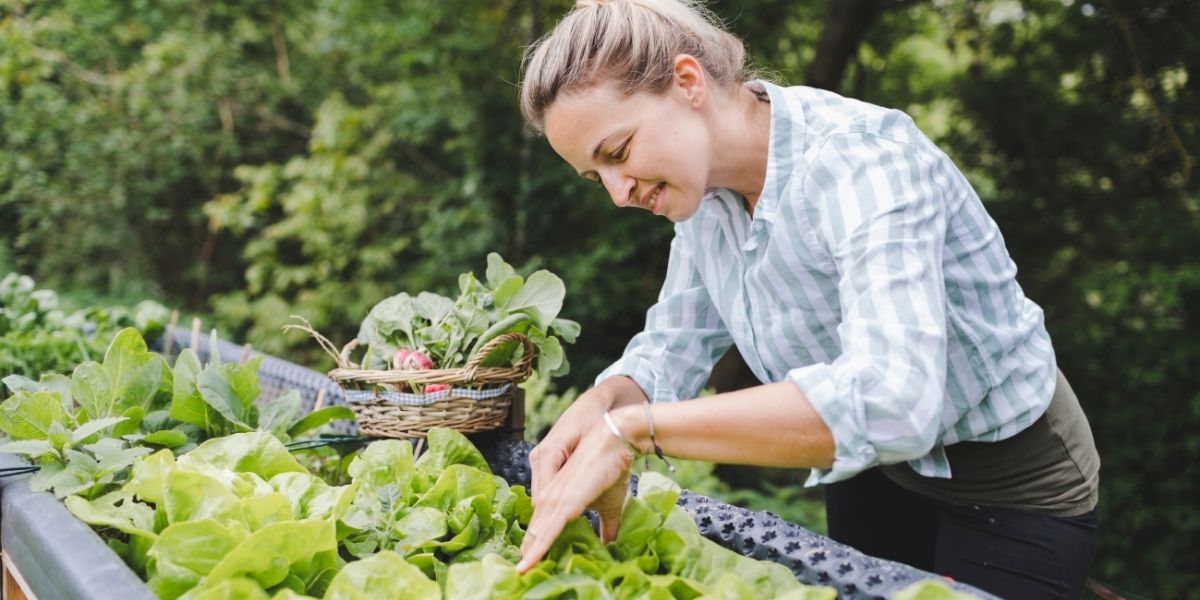There are several plants you can cultivate in raised bed gardens with the right conditions. Think about the numerous options.
A raised bed garden is a creative way to plant your veggies, flowers, shrubs, and whatever you love.
In raised bed gardens, you can control the soil for quality, creating a warm, well-draining, nutrient-rich growing environment for optimal root development and plant growth.
Raised beds can be designed in several ways so that you can get creative. It can be constructed from wood, metal, stone, and brick, but what to plant in a raised garden bed? Let’s explore some fabulous options.
Table of Contents
Fruits and Vegetables
Fruits and veggies are one of your top picks as they have a high need for nutrients, which makes them thrive in raised bed gardens. Here is a list of your favorite fruits and vegetables.
Tomatoes
Tomatoes grow best in loose grounds where they can stretch their roots deep. They are sun-loving plants that can grow at the end of the raised garden bed. You can add a tomato cage for support.
The soil is also warmer, which gives tomatoes an extended season for early and late-season crops. It also has the advantage of covering the raised bed for a fall and winter harvest.
Brassicas
Brassicas are great for raised bed gardens but tend to be affected by hot climates. Thankfully, they will love the regulated temperature-raised bed gardens provide.

Legumes
Legumes are a great nitrogen attractor. So, they double as plant and soil nutrient boosters. Legumes have free-climbing varieties and freestanding species, and both can be planted in raised bed gardens.
Kale and Swiss Chard
If you need to plant some late-season crops in your raised beds, kale and Swiss chards are perfect.
They help to keep the soil compact and can be covered with cold frames or hoop houses to increase their growing season. These plants love cooler temperatures, so you are sure of a great harvest during winter and fall.
Carrots
Carrots always meet the list of a raised bed plant. Raised beds have loose, well-drained soil, which carrots love compared to the rocky ground. But they can easily be kept under taller planting protection since their fruit grows underneath.
Beets and Radishes
Beet plants and radishes love loose soil like carrots and will always do well in raised gardens. Since they mature fast, they make an ideal succession-plant crop.
Celery
All it needs is to settle in the roots of a raised garden bed. Celery requires nutrient-filled soil with moisture and cool temperature. They also help to keep root nematodes and aphids away.
Potatoes
Potatoes love raised gardens as growing them in well-draining soil prevents them from rotting. The loose soil also enabled the tubers to form fully without any hindrance from rocks or dense soil. Potatoes thrive in a raised garden bed.
Peppers and Eggplant
Fun pepper and eggplant are heavy feeders of nutrients and thrive in raised bed gardens. So it is easy for a gardener to provide plants with the nutrients and water they need while in a raised garden.
Cucumbers
Cucumbers will flourish in raised beds. Allow them to cascade over the sides of raised beds or up trellises to maximize space for these prolific fruiting plants.

Melons
Melons do great in raised beds. They love warm, nutrient-filled, pH-balanced soil with the right drainage.
Plant them around the edge of the raised garden where they can spin around. You can also use a trellis with all other structures to maximize space.
| Plant Type | Plant Varieties | Planting Time | Sun Requirements | Soil Preparation | Special Considerations |
|---|---|---|---|---|---|
| Vegetables | Tomatoes, Peppers, | Spring (after | Full sun (6-8 hours | Well-drained, rich | Use tomato cages or |
| Cucumbers, Zucchini, | last frost) | per day | soil with compost | trellises for vining | |
| Lettuce, Spinach, | Berry bushes. | ||||
| Carrots, Radishes | |||||
| Herbs | Basil, Thyme, | Spring or fall | Full sun to partial | Loose, well-drained | Prune herbs to promote |
| Rosemary, Parsley | sun (4-6 hours per | soil with organic | bushier growth and | ||
| day) | matter | enhance flavor. | |||
| Fruits | Strawberries, | Early spring | Full sun (6-8 hours | Sandy loam with good | Use straw mulch for |
| Aries, Dwarf Fruit | or late summer | per day | drainage | strawberries. | |
| ries, Dwarf Fruit | Consider trellising | ||||
| Trees (e.g., Dwarf | Blueberries, Raspberry- | ||||
| Apple, Peach) | |||||
| Flowers | Marigolds, Petunias, | Spring or fall | Full sun to partial | Well-drained soil with | Deadhead spent flowers |
| Zinnias, Sunflowers | sun (4-6 hours per | organic matter | for continuous blooms. | ||
| day) | |||||
| Root Vegetables | Beets, Carrots, | Early spring or | Full sun to partial | Loose, well-drained | Thin seedlings for |
| Radishes, Turnips | late summer | sun | soil, free of rocks | proper spacing. | |
| and debris | |||||
| Climbing Vines | Peas, Beans, Cucum- | Spring (after | Full sun to partial | Enriched soil with | Provide support for |
| bers (vertical | last frost) | sun (4-6 hours per | compost or organic | climbing varieties. | |
| trellis), Melons | day) | matter |
Strawberries
Strawberry plants grow abundantly in warm soil with plenty of sunlight. And raised bed garden provides it all. It also protects the plant from menacing pests like slugs that feed on its fruits.
Other plants include:
- Broccoli
- Cauliflower
- Arugula
- Cabbage
- Kale
- Brussel Sprouts
- Chickpeas
- Bush and Pole Bean Varieties
- Peas
- Lentils
Frequently Asked Questions [FAQs]
1. What Are The Best Vegetables To Plant In Raised Bed Gardens?
The best vegetables for raised bed gardens include tomatoes, peppers, lettuce, carrots, and zucchini. These plants adapt well to the controlled environment of raised beds.
2. How Deep Should A Raised Bed Garden Be For Optimal Plant Growth?
For optimal plant growth, a raised bed garden should be at least 10-12 inches deep. This depth allows for proper root development and water retention.
3. What Type Of Soil Should I Use For My Raised Bed Garden?
Use a well-draining, nutrient-rich soil mix for raised bed gardens. A mix of topsoil, compost, and perlite or vermiculite works well to provide good drainage and nutrients for your plants.
4. Can I Grow Herbs In A Raised Bed Garden?
Yes, herbs like basil, mint, rosemary, and parsley thrive in raised bed gardens. Their compact growth makes them ideal for small spaces.
5. How often should I water my plants in a raised bed garden?
The frequency of watering depends on the weather and the type of plants. Still, as a general guideline, water your raised bed garden 1-2 inches per week, ensuring the soil remains consistently moist but not waterlogged.
Wrap Up!
The possibilities of what you can plant in raised bed gardens are endless. Regardless of what you plant, ensure to engage in routine maintenance of your garden. Fortunately, the garden style is also easier to maintain. Also, supply the appropriate nutrients, water, feed, and other things your plants need for abundance, growth, and harvest.

